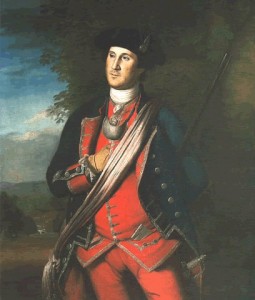
George Washington:
First in War,
First in Peace, and
First in the Hearts of His Countrymen
George Washington truly was the “Father of our Country”. He was a great man devoted to “republicanism and civic virtue”. Sadly, much of his greatness has been forgotten today.
In war he was the Hero of the Monongahela, where “he had two horses shot out from under him, and four bullets pierced his coat—yet, he sustained no injuries and showed coolness under fire,” in the French and Indian Wars. In the War for Independence, he was appointed Commander in Chief of the Continental Army. Even the enemy praised his personal character, endurance, courage and care for the men he was leading. The Delaware River crossing and Valley Forge are just two instances of his heroism in this war.
In peace, he was persuaded to attend the Constitutional Congress, where he was unanimously elected the President of it. In the hearts of his countrymen, he was again unanimously elected as President, of our nation, for 2 terms. He is still the only President to receive 100% of the electoral vote.
In honor of George Washington’s upcoming birthday, and today as Presidents’ Day, here are a few resources to help you celebrate by studying his life.
Bulletproof George Washington – a great short account of an event in Washington’s life, and God’s Providential care through it.
 |
Bulletproof George Washington
By David Barton / Wallbuilders One of the turning points in the young George Washington’s life took place July 9th, 1755, in a French & Indian War battle. The only officer on horseback not shot down, the 23-year old Washington knew that his life was in God’s hands, and he offered God liberal gratitude for his deliverance. This short book offers an interesting look at an event in Washington’s life not often talked about, with many historic illustrations and artifact photographs. 62 pages, softcover. |
Rules of Civility – Washington wrote these maxims when he was 14 years old. They obviously were foundational to the character he exhibited when older. They make great Copywork for our children today.
 |
George Washington’s Rules of Civility & Decent Behaviour in Company and ConversationBy Applewood Books
This collection of George Washington’s maxims is contained in a handsome hardcover. 110 of his rules, written at age 14, are comprised of both common-sensical rules such as not talking with meat in your mouth, to more unique rules such as not spitting in the fire. 30 pages, 4.25″ x 6.75″. Red Imitation-Leather like cover with imprinted gold title. Hardcover, 30 pages. |
George Washington: the Character and Influence of One Man – from Washington’s own writings and others in his own time.
 |
George Washington: The Character and Influence of OneBy Verna M. Hall / F.a.c.e.
As pundits wonder if America’s political leadership will be restored in the 21st century, Hall looks to our past—and finds a remarkable example of Christian character and courage. Teens will be fascinated by these excerpts from Washington’s writings and accounts by his contemporaries, emphasizing his faith in God’s sovereign will for the United States. 480 pages, 8.5″ x 11″ hardcover from F.A.C.E. |
Biographies of Washington for youth and children – listed from hardest to easiest.
 |
Apostle of Liberty The World-Changing Leadership of George WashingtonBy Stephen McDowell / Cumberland House Publishing
George Washington holds the title of the “Father of our Country”, and many behold him as a leader for Christianity and Liberty. Exploring his character, ethics, religion, actions as a general, wisdom as a president, and his legacy, Washington: Apostle of Liberty paints a portrait of a leader whose beliefs changed the world. 320 indexed pages, hardcover with dust jacket. |
 |
The Life of George WashingtonBy Mary L. Williamson / Christian Liberty Press
Love of liberty—and God—compelled George Washington to serve his country. This easy-to-read biography details the president’s accomplishments as statesman, soldier, farmer, and family man and reveals how his exemplary Christian character, values, and ideals shaped the beginnings of American politics. Inspirational reading for ages 10 and up. 120 pages, softcover. |
 |
Heroes of History: George Washington, True PatriotBy Janet & Geoff Benge / Emerald Books
With consistent historical depth and an engaging narrative style, Heroes of History chronicles the remarkable true stories of fascinating men and women who changed the course of history. A biography of George Washington, Commander in Chief of the Continental Army and first president of the United States. Unit study guide sold separately #002877. |
 |
George Washington, Sower SeriesBy Mott Media, Llc
See history come alive…learn of many hidden facts involving famous men and women from the pages of their diaries, letters to friends, books they wrote, etc. Washington was not a preacher or great Bible scholar, and he did not speak or act in this manner. He was much like the average member of your church, for he sat regularly in the pews of many churches. Daily Washington lived by the biblical teachings he gleaned from his Bible reading. And he was a sower of the seeds of faith to others. For ages 9 to 13. |
Want something FREE and today? Download either of the following for FREE today!
CurrClick is offering Presidents’ Day Holiday Helper from Living Books Curriculum, a Charlotte Mason approach. Sign up for their newsletters to know what their weekly free item is.
Homeschool Freebie of the Day has several website links they’ve gathered that would be helpful to home educators studying George or Abe. Be sure to sign up for their email list that lets you know what the Freebie of the Day is for each day in the coming week.
*Note: Picture is the first known painting of George Washington – by Charles Willson Peale.

















